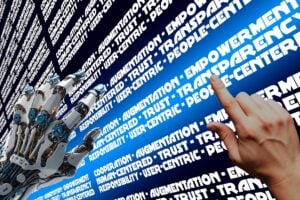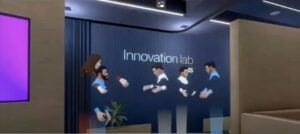Virtual natives and interconnected realities—know that we are referencing two books that you wrote simultaneously. But the books highlight two different things. One is people, and one is kind of platforms. Those are my words, not yours.
“I would also say that one is my professional life and one is my personal life, except they each blend into each other,” says Shannon. “Fundamentally, one is about mixed reality, augmented reality, what exists today and where it’s developing and what the trajectory is and what to look for. And the second one is digital anthropology. It looks at Gen Alpha and Gen Z, who are basically everybody born since the year 2000, and how they use digital media and computing tools and why it’s significant. For the last 50 years, we’ve had kids who were actually using some kind of computing. Why is this generation different? What is it going to mean for both work and society going forward? That’s really the question that I and my coauthor got into in Virtual Natives.”
What we’re bringing from those lessons into this session is what corporates can do about it.
“Absolutely,” she says. “We were both seeing evidence that there was different behavior in younger people, and we really wanted to explore that. And we also were hearing all of the extremely negative reporting that’s out there in the media about social media. I’ve got two teenagers myself. That was not the experience that we were seeing in our own intersection with this cohort. We started exploring that. What are the positive sides of young people’s interactions with computing? Where it ended up was back to the topic of work, and it kept coming back to how this cohort behaves differently in the workplace, and how things are changing and the disruptions that they are going to bring. It’s not just about making a flexible work policy. It goes much deeper because they’re going to be disrupting industries.”
You can take some lessons about these consumers, but you can also take lessons about this cohort of talent that is and will be in your organization.
Shannon adds, “It will be necessary to your organization because their way of thinking is unchained from the restrictions of the past and their imagination and their computing prowess is absolutely vital to innovation. It’s the canny organization that actively recruits younger people and treats them the way they want to be treated.”
Is it the fact that computing prowess, which has been high for generations coming into the workforce for quite some time, is it different with this generation because of the democratization and distribution of computing power?
“It’s certainly far more democratized,” relates Shannon. “It’s more that this generation has come at a time where they are no longer aware of that they haven’t lived the original processes, the analog process, the things in the physical world that our computing has since replaced. An example is email. And we call it email mail, and it’s a little envelope icon. If I hand an envelope and a piece of paper and a stamp to my children and say, here, write a letter, put it in the envelope, address the envelope, put a stamp on—they don’t know how to do that. They genuinely ask, where do I write what? They genuinely do not have experience with licking envelopes, sealing them, and putting them in the mail. For them, the envelope icon is this strange relic of the past. And for them, it’s always been electronic because they don’t have the original structure of what physical mail was. For them, when they look at email, they think this is a highly inefficient process. Why am I sending one thing just to one person, when something like Discord or Slack is a much more efficient structure.”
Shannon continues, “That’s really the metaphor for almost everything that’s happening. Our generation created a computer version of the analog thing that was there. We created email. And our kids are looking at it and going, why? Because they are not familiar with the original thing that it replaced. They’re finding better ways to do things. It makes far more sense for me to send you a message that goes with this project and it lives with the life of the project and everybody needs to see it rather than me sending the equivalent of an interoffice memo in an envelope that nobody else can see. It’s their ability, their impatience with the slow speed of the world that we’ve created because they have the tools to do things much more quickly. They’re coming into adulthood. The oldest among them are 24. They’re just coming out of college. They’re just going into the workforce, and they’re hitting inefficiencies and going, really? There’s got to be a better way.”
This is a “but now we have to do something about it” moment.
“We talk about both the importance of understanding this cohort as valuable employees and as customers. Because as customers also, they are applying different criteria to your product. There’s things that they value, authenticity is extremely important to them, and the things that let them participate, and things that let them have a voice and help to shape things,” she says.
Attend FEI 2024
Looking forward to FEI 2024? The conference, which will be held June 10 to 12, will feature a session called “Guidance From Virtual Natives & Interconnected Realties,” presented by Leslie Shannon, Head of Trend and Innovation Scouting, Nokia. This session blends the lessons learned from both of her books into a slew of actionable takeaways on how you can evolve your organization. Understanding now deeply embedded GenAI will be in our culture moving forward; breaking us away from screens and providing information via context-based means; understanding that Gen Z is at home with that technological evolution; seeing your organization differently through the eyes of virtual natives and meeting them where they are; recognizing that there are no analog limits to the imaginations of virtual natives; and realizing that organizational resilience is dependent on adapting to how humanity is developing. Register for FEI 2024 here.
More Innovation Resources
Connecting Reality and Technology Through the Metaverse
Just what is happening with the metaverse? All Things Innovation’s Seth Adler caught up with Leslie Shannon, Head of Trend & Innovation Scouting, Nokia, at the FEI conference earlier this year to discuss the metaverse, its evolving status, innovation and all points in between. This follows the publication of Shannon’s new book, “Interconnected Realities: How the Metaverse Will Transform Our Relationship with Technology Forever.”
What matters in the metaverse is what matters in any ‘verse.’ Brands must have metrics in place to measure performance. Organizations must have signals in place to capture customer feedback. There must be a promise and understanding in place regarding the engagement experience– something of course with unique opportunities in this new space. And of course, the potential business impact must be understood and quantified. This panel outlines how to act now within each of these areas of interest.
Contributors
-

Seth Adler heads up All Things Insights & All Things Innovation. He has spent his career bringing people together around content. He has a dynamic background producing events, podcasts, video, and the written word.
View all posts -

Matthew Kramer is the Digital Editor for All Things Insights & All Things Innovation. He has over 20 years of experience working in publishing and media companies, on a variety of business-to-business publications, websites and trade shows.
View all posts

























































































